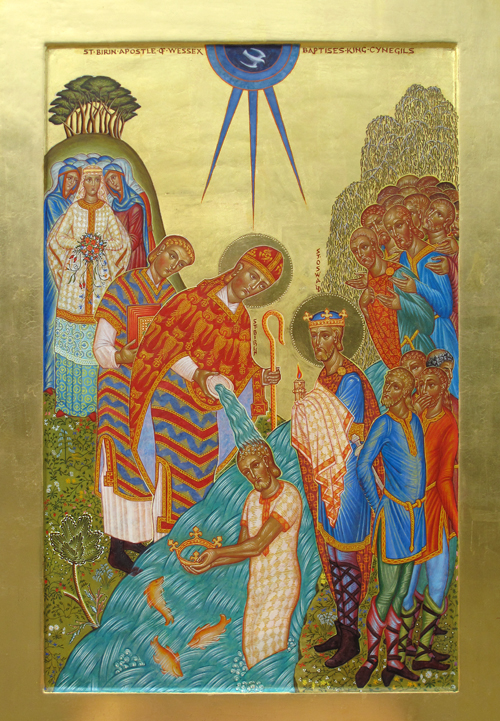This article is the first in a new series, Essential Wessex, outlining key moments in Wessex history
St Berin, more commonly known by the Latinised form of his name, Birinus, was a Frankish bishop sent by Pope Honorius I to convert the pagan Anglo-Saxons. He was originally destined for Mercia, but upon arriving in the kingdom of the Gewissae, located in the upper Thames Valley, felt that his calling was here. He landed at Hamwic (Southampton) in 634, and was given permission to preach by King Cynegils the following year. Cynegils’ motives were not purely based in religious conviction. His daughter was to marry the Christian King Oswald of Northumbria, and a conversion to Christianity made for a politically savvy move.
According to a legend depicted in stained glass at Dorchester Abbey, Birinus gave mass before boarding a ship and left behind a corporal (altar cloth) that had been gifted to him by Pope Honorius. He jumped overboard, retrieved the corporal and rejoined the ship, which had been miraculously becalmed despite an offshore wind, walking upon the water without getting wet.
Back in the real world, Berin was known to have baptised at a pond known as Bapsey Pool (a corruption of the word “baptism”) at Taplow, though the baptism of Cynegils probably took place at Dorchester-on-Thames, an important settlement that subsequently became Berin’s see. The see of Dorchester lapsed some time around 685, as Mercian expansion gobbled up Gloucestershire and Oxfordshire, forcing the bishopric of the West Saxons southward to Winchester. The last bishop of Dorchester before its absorption into the see of Lichfield was a Mercian, Ætla, with his West Saxon predecessor Agilbert being reassigned to Paris. The see was re-established in 886 by King Alfred, covering much of the Danelaw.
Berin was very active in establishing churches in what is now the northern part of Wessex, including the parish church of St Mary’s in Reading. Berin’s Hill near Ipsden and the town of Berinsfield, both in Oxfordshire, are named after him. He died on 3rd December 650 (649 according to some sources), and buried at Dorchester Abbey, though his relics were later transferred to Winchester Cathedral. His feast day is observed on 3rd December in the Roman Catholic and Orthodox Churches, but 5th December in the Church of England.
Until recently, the Anglican feast day was the date of a pilgrimage that departed from Churn Knob near Blewbury, a neolithic burial mound that may have been chosen for Berin’s preaching due to already being recognised as a sacred site. Wessex Society members joined the pilgrimage in one the early years of the Society’s founding (I believe it was 2000, but I have no record, so I cannot be absolutely sure), braving torrential rain and swamp-like mud for a walk of approximately eleven miles. The pilgrimage route is available to members of the Walking World website, or non-members can buy the route for a small fee of £1.95. Perhaps one year, the Society might revive the walk.

